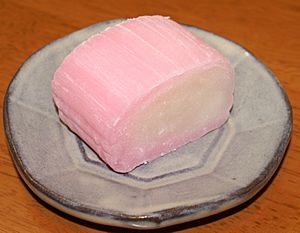Suama facts for kids
 |
|
| Type | Wagashi |
|---|---|
| Place of origin | Japan |
| Main ingredients | Non-glutinous rice flour, hot water, sugar, red food dye |
Suama (寿甘) is a special Japanese sweet. It is made from non-glutinous rice flour, hot water, and sugar. One of its most noticeable features is its bright red color. The name "Suama" combines two Japanese characters, called kanji. "Su" (寿) means celebration, and "ama" (甘) means sweet.
What is Suama?
Suama is a type of wagashi, which are traditional Japanese sweets. These sweets are often served with tea. Suama gets its vibrant red color from food dye. In Japanese culture, the colors red and white together are symbols of celebration and good luck. This is why Suama is often made for special occasions.
How is Suama Made?
Making Suama involves a few simple steps. First, the non-glutinous rice flour is mixed with hot water and sugar. This mixture is then kneaded, much like dough for bread. Kneading helps to make the sweet smooth and chewy.
After kneading, the Suama can be shaped. Sometimes, it is pressed using a special mat called a sudare. A sudare is a bamboo mat, similar to what is used to roll sushi. Using this mat gives the Suama a cool, slightly bumpy texture on its surface.
Suama and Other Japanese Sweets
Suama is a unique sweet, but it is sometimes confused with other Japanese rice-based snacks. Two common ones are mochi and uirō. While they all use rice, they are made differently.
- Mochi: This sweet uses glutinous rice flour. Glutinous rice flour makes mochi very sticky and stretchy. Suama, however, uses non-glutinous rice flour, which gives it a different texture.
- Uirō: Unlike Suama, uirō is not kneaded. Instead, its ingredients are mixed together, poured into a mold, and then steamed. This process gives uirō a softer, more jelly-like texture compared to Suama.
So, while all three are delicious Japanese treats made from rice, Suama stands out with its special kneading process, non-glutinous rice flour, and festive red color.

